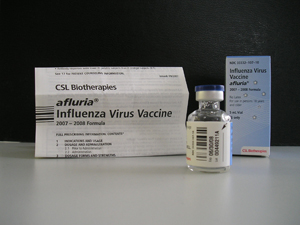Product
Afluria
Approval Date
September 28, 2007
Release Date
November 21, 2007
Company
CSL Biotherapies
Class
Influenza vaccine
Indication
Influenza immunization
Active Ingredient
Trivalent, inactivated, “split virus” influenzavaccine (Types A and B); formulation changes annually; susp for IM inj; maycontain trace amounts of neomycin sulfate, polymyxin B.
Agency Roster
The Hal Lewis Group (professional, DTP)
MarketingStrategy/Execution
All flu vaccine manufacturers have a common goal: to get people to the doctor for their flu shot. That’s a big challenge to a brand considered the same by physicians. CSL Biotherapies, marketer of Afluria, is using a mix of professional and DTP promotion it hopes will drive more consumers to see a healthcare provider. The mix includes event marketing activities, such as targeting moms in malls to get vaccinated. On the professional side, CSL will use advertising to stress, in addition to the advantages of its injectable product, its commitment to addressing a public health need, as well as greater choice. A thimerosal-free formulation is available.
The Market
| Influenza US sales ($000s) last 5 years | |
| 2006 | $674,150 |
| 2005 | $381,009 |
| 2004 | $108,659 |
| 2003 | $346,907 |
| 2002 | $207,656 |
| Source: IMS Health, Nov. 2007 |
|
| Top 5 influenza | ||
| Jan.-July ’07 US sales ($000s) | % sales growth over Jan.-July ‘06 | |
| FLUVIRIN (Novartis) | $148,218 | 24% |
| FLUZONE (Sanofi Pasteur) | $98,042 | 272% |
| FLUARIX (GlaxoSmithKline) | $48,440 | 27% |
| FLULAVAL (GSK) | $13,780 | *** |
| FLUMIST (MedImmune) | $980 | 14% |
| Source: IMS Health, Nov. 2007 |
||
Also in the Pipeline(according to Adis R&D Insight)
Drug: FluBok
Manufacturer: ProteinSciences/UMN Pharma
Indication: Influenzavirus infections prevention
Active ingredient: Recombinantversion of influenza A/H3 haemagglutinin (rHA) protein
Phase: III
Drug: Seasonalinfluenza virus vaccine intradermal
Manufacturer: sanofipasteur
Indication: Influenzavirus infections prevention
Active ingredient: Seasonalinfluenza virus vaccine
Phase: III
Drug: Seasonalinfluenza virus vaccine intramuscular
Manufacturer: sanofipasteur
Indication: Influenzavirus infections prevention
Active ingredient: Seasonalinfluenza virus vaccine
Phase: III
Source: Wolters Kluwer Health, Nov. 2007
Recent MM&M Coverage
TheTop 60: The Hal Lewis Group
Pharmacology
Influenza is a highly contagious and potentially fatal viral disease thatcan reach epidemic levels and pose a significant threat to public health.Influenza immunization may help in preventing the flu and its severecomplications. Because the virus is capable of changing frequently, protectionis limited to those strains of virus from which the vaccine is prepared andpossibly to closely-related strains.
Afluria is an inactivated influenza vaccine that contains thehemagglutinins of three virus strains representing those flu viruses consideredlikely to circulate in the upcoming winter. Annual vaccination with the currentvaccine is necessary because immunity declines during the year aftervaccination. Vaccine prepared for a previous flu season should not be given toprovide protection for the current season. As for any vaccine, this product maynot protect 100% of susceptible individuals.
The multi-dose formulation contains the preservative thimerosal, amercury derivative. Each dose contains 24.5mcg of mercury.
Clinical Trials
Three randomized, controlled studies have evaluated theimmune responses of over 2,000 subjects (HI antibody titers) to each virusstrain in the vaccine. Study 1 conducted in the US, was a double-blind placebocontrolled study. Studies 2 and 3 were conducted in the UK, comparingAfluria with a European-licensed trivalent inactivated influenza vaccine as anactive control. Post-vaccination immunogenicity was evaluated on sera obtained21 days after administration of Afluria. Antibody titers 1:40 or greater havebeen shown to protect against influenza illness in up to 50% of subjects insome human studies. Therefore, each of the three studies for Afluria evaluatedfor 1) seroconversion rate (4-fold increase in post-vaccination HI antibodytiter from pre-vaccination titer); and 2) HI titer = 1:40 for each of the threevaccine strains. The proportion of subjects with a minimum post-vaccination HIantibody titer of 1:40 had to meet a lower bound 95% CI of >70% in the US study and >60% and >70%, in the UK studiesrespectively. Each of the three studies met co-primary endpoints ofimmunogenicity. Post-hoc analysis of one UK study found that serum HIantibody responses were lower in subjects age 65 years and older afteradministration of Afluria. Serum HI antibody responses to the active controlwere similar to those for Afluria. No studies were performed demonstrating adecrease in influenza illness after vaccination with Afluria.
Adverse Reactions
Local reactions (eg, tenderness, redness, swelling, pain),headache, malaise, muscle aches.
Adults
=18yrs: 0.5mL by IM inj once in deltoid.
Children
<18yrs: not recommended.
Contraindications
Allergy to egg or chicken proteins, neomycin, polymyxin.Life-threatening reaction to any previous flu vaccine.
Precautions
Use current formulation only. Have epinephrine inj (1:1000)available. Guillain-Barre syndrome within 6 weeks of previous flu vaccine.Immunosuppressed. Pregnancy (Cat.C). Nursing mothers.
Interactions
Concomitant vaccines: insufficient data (see literature).Immunosuppressants (eg, corticosteroids): may get suboptimal response.








